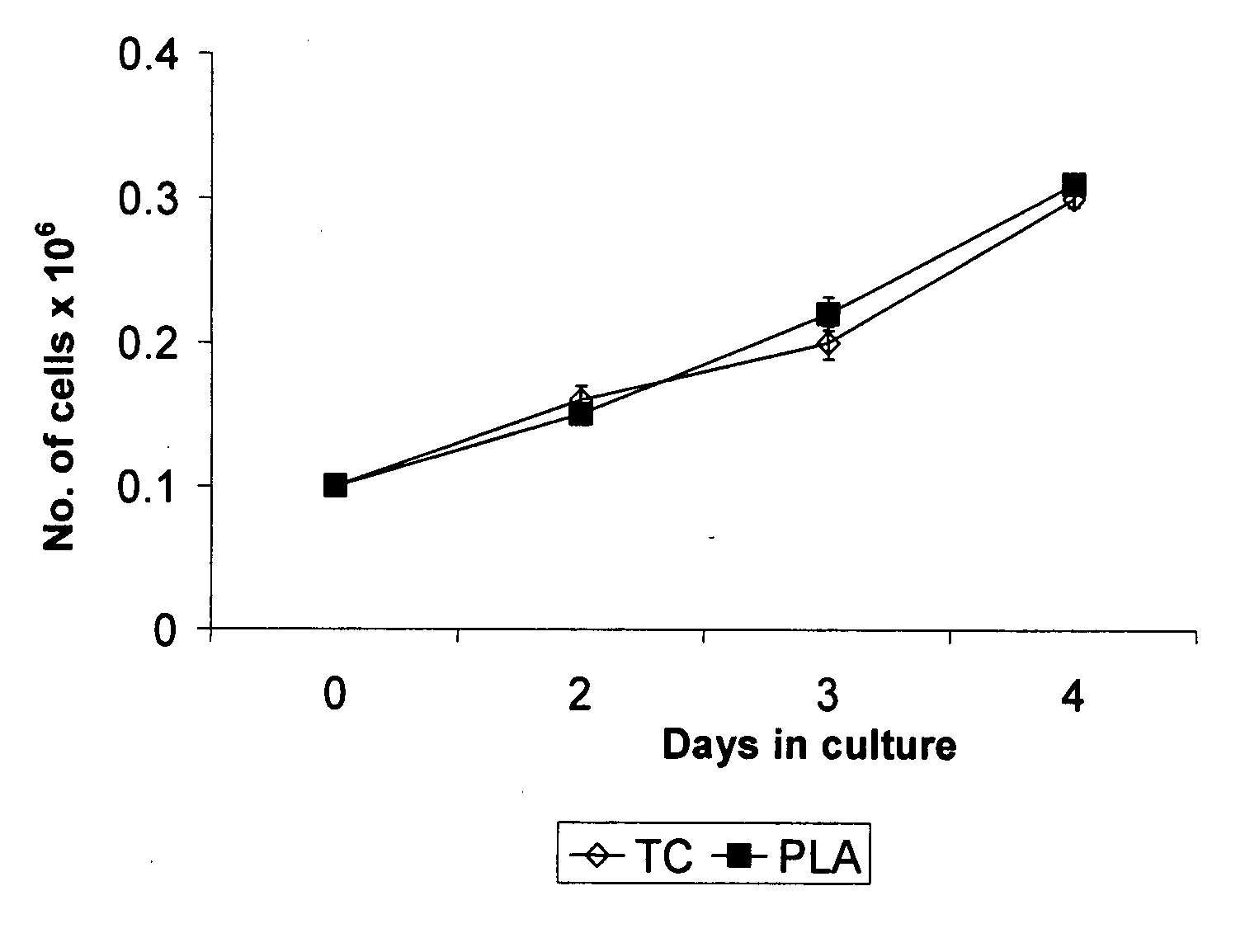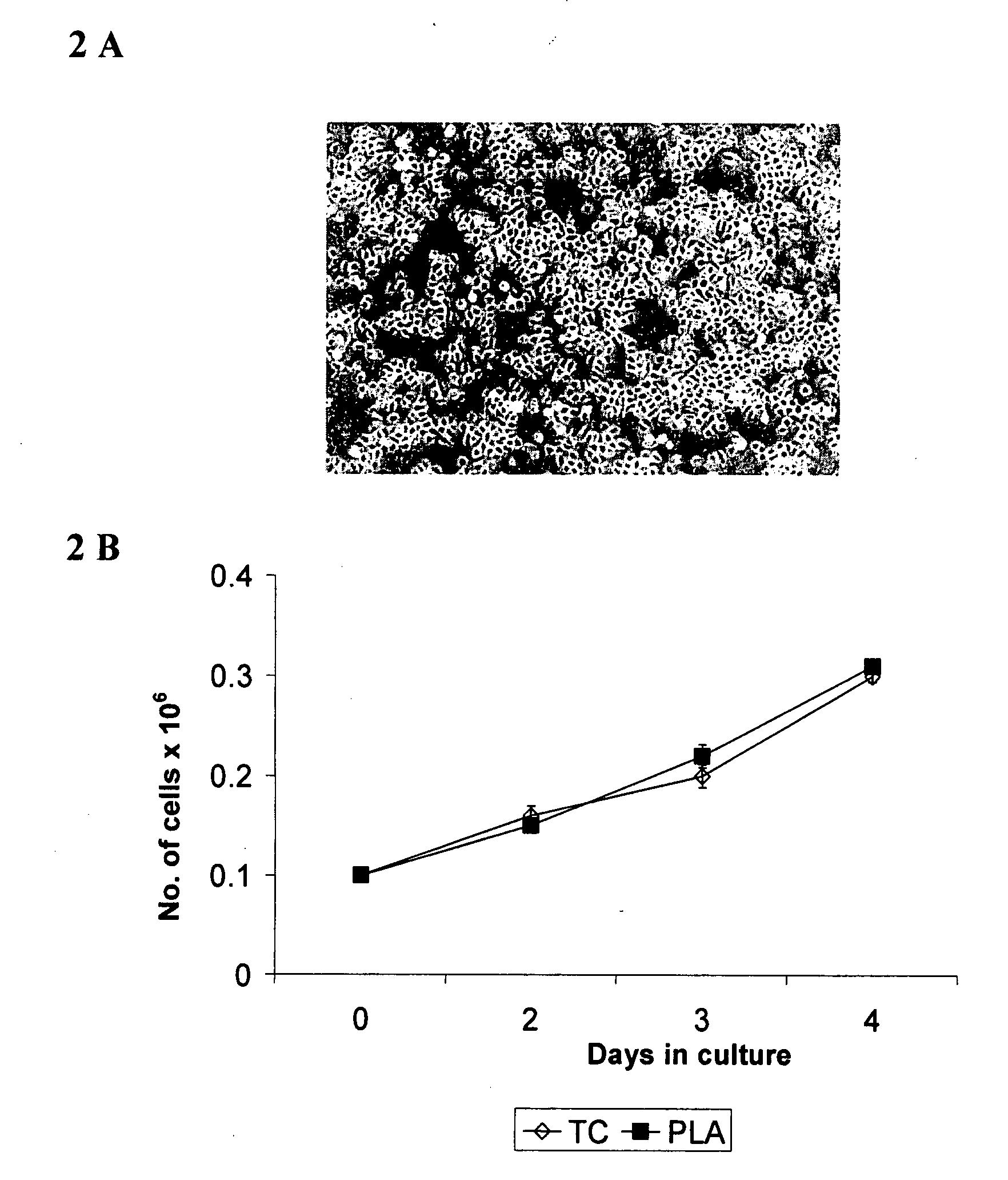Interactive wound cover
a wound cover and active technology, applied in the field of interactive wound covers, can solve the problems of inferior scars, inability to repair damaged areas, cosmetically and functionally, and inability to manufacture wound covers, etc., and achieve the effect of accelerating skin tissue regeneration and rapid production of wound covers
- Summary
- Abstract
- Description
- Claims
- Application Information
AI Technical Summary
Benefits of technology
Problems solved by technology
Method used
Image
Examples
example 1
Preparation of the Wound Cover
A) Preparation of the PLA Sheets
[0094] The polymer was specially made by mixing equal amounts of L and DL dilactide, and polymerized to give PLA with a molecular weight of about 50,000-150,000 Da. A 20% (w / v) solution of the polymer was prepared in acetone and clarified to remove any suspended particles by centrifugation. The polymer film was then prepared by solvent casting method by pouring the solution over a solid support such as glass or steel plates. The sheets were allowed to dry by evaporation of solvent at ambient temperature; rinsed in sterile water and dried at ambient temperature. PLA film was sterilized with Ethylene Oxide (ETO).
[0095] Physical properties of ETO sterilized films were characterized using standard methods (IS / ASTM). Barrier property of the films against microbes (bacteria, yeast and fungi) was assessed by the ability of the films to prevent contamination of the underlying nutrient mix.
[0096] Physical characteristics of t...
example 2
Product Characterization and Testing
A) Microbial Testing:
[0102] 1) Bioburden: The microbial contamination in the sample was determined in terms of numbers of colonies appearing on plates of solid media. The test involved the addition of sterile molten Casein Digest Agar to 1 ml of test sample in a petri dish. After solidification of the medium the plate was incubated at 30-35° C. in the inverted position for 48 hours. After this period the plates were visually inspected. No bacterial growth was observed.
[0103] 2) Sterility testing: Sterility testing was performed to detect the presence of aerobic and anerobic microbes by inoculating the test samples in two different sterile nutritive medias namely Fluid Thioglycolate Medium (FTM) and Soybean Casein Digest Medium (SCDM). The result showed absence of growth during a period of 14 days for microorganisms such as bacteria, yeast and mold and for pathogens like E. coli, S. aureus, P. aeruginosa and Salmonella indicating sterility of t...
example 3
In Vivo Testing
A) Migration of Keratinocytes from PLA
[0119] To enhance wound healing, keratinocytes should be delivered to the wound bed. Once the wound cover is applied to the wound bed, cells must migrate from the PLA membrane to the wound bed. To confirm this event, an in vivo experiment was performed on guinea pigs. Briefly, partial thickness punch wound biopsies were created on the posterior portion of the animals. Cells in a wound cover of the present invention were labeled with a red fluorescent dye (CyDiI, Molecular Probes, USA) and then applied on the wound bed. At the end of 3 days, the wound was excised and processed for histological analysis. As shown in FIG. 6, fluorescent-labeled cells were visualized in the wound bed, indicating migration of keratinocytes from the PLA sheet to the wound bed.
B) Preclinical Evaluation:
[0120] The toxicity testing was done with a PBS solution with the PBS sheet for 72 h at 37° C. (hereinafter “test substance”). All toxicity studies ...
PUM
| Property | Measurement | Unit |
|---|---|---|
| molecular weight | aaaaa | aaaaa |
| melting point | aaaaa | aaaaa |
| temperature | aaaaa | aaaaa |
Abstract
Description
Claims
Application Information
 Login to View More
Login to View More - R&D
- Intellectual Property
- Life Sciences
- Materials
- Tech Scout
- Unparalleled Data Quality
- Higher Quality Content
- 60% Fewer Hallucinations
Browse by: Latest US Patents, China's latest patents, Technical Efficacy Thesaurus, Application Domain, Technology Topic, Popular Technical Reports.
© 2025 PatSnap. All rights reserved.Legal|Privacy policy|Modern Slavery Act Transparency Statement|Sitemap|About US| Contact US: help@patsnap.com



